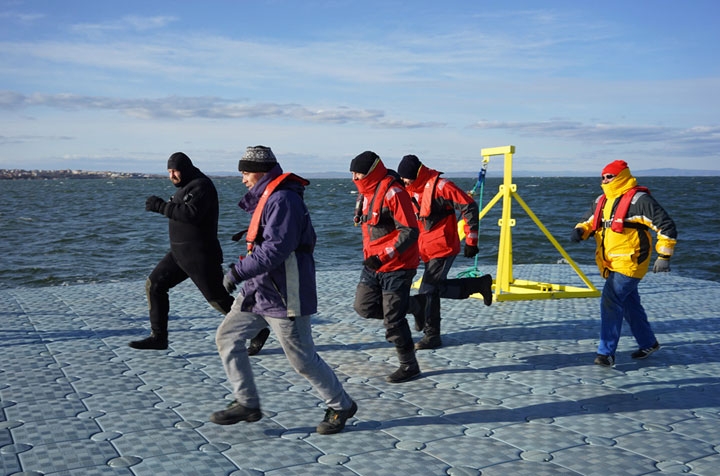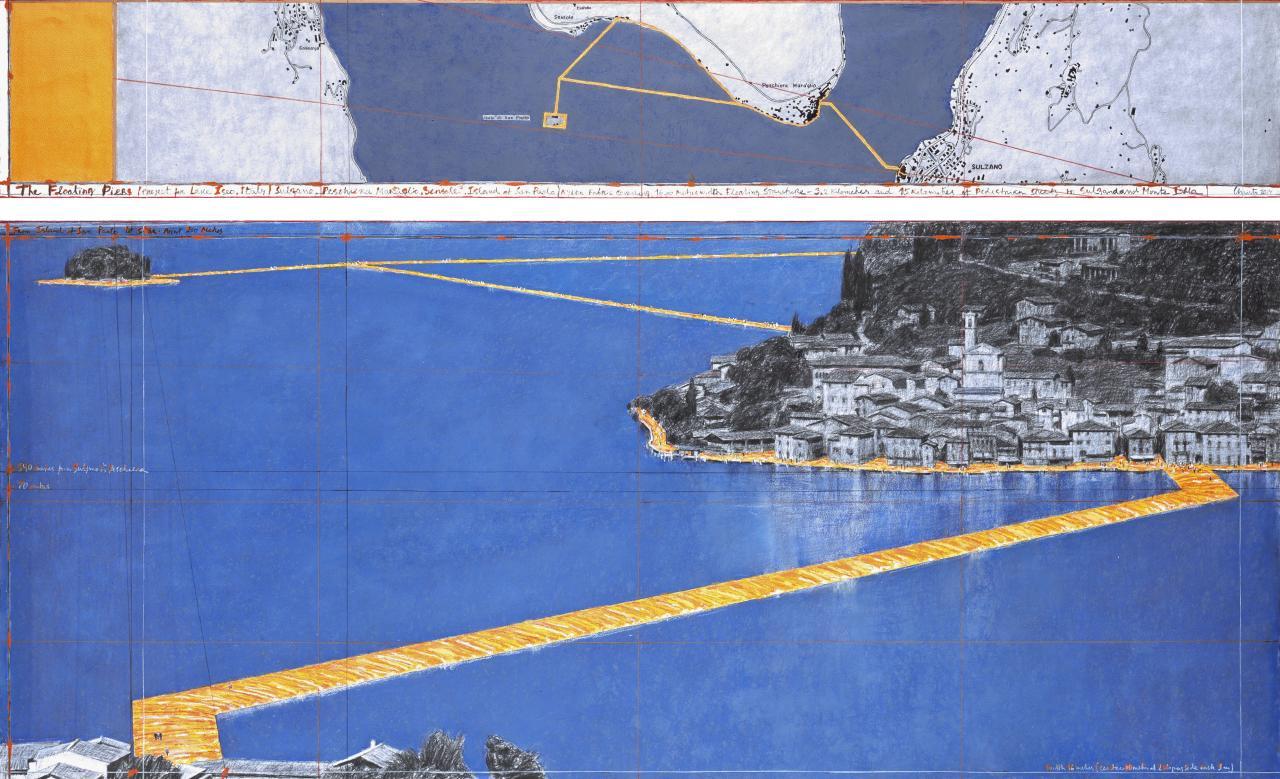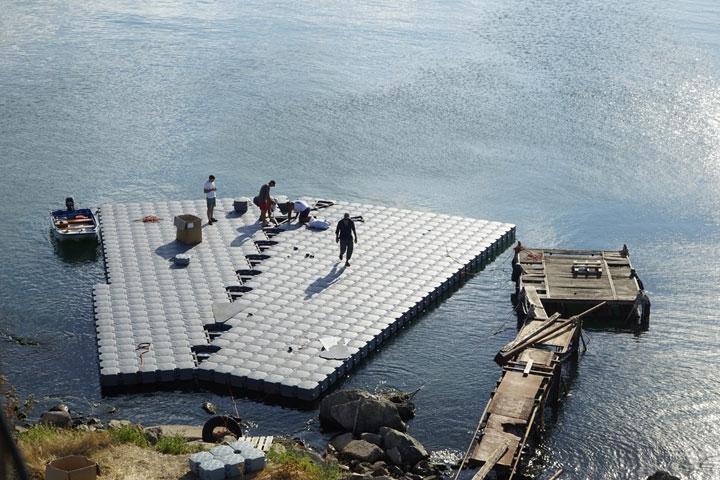February 12, 2016 Updated 2/12/2016
Email Print

Wolfgang Volz/Christo Testing a concept for Christo’s art project in the Black Sea.
For two weeks this summer, the artist Christo will turn an Italian lake in the foothills of the Alps into his latest participatory art project, building long, temporary bridges of plastic to form walkways stretching several kilometers over the water.
The 80-year-old Christo has built a career with fantastical public art like his 2005 work “The Gates,” which covered 26 miles of walkways in New York’s Central Park with thousands of overhanging structures draped in colorful fabric.
Now, he said he’s going to use 200,000 blow molded polyethylene cubes to build 50-foot-wide bridges stretching 3 kilometers across northern Italy’s Lake Iseo and cover them with shimmering yellow fabric for a piece of art dubbed “The Floating Piers.”
“Visitors will experience this work of art by walking on it from Sulzano to Monte Isola and to the island of San Paolo, which it encircles,” while the bridges “undulate with the movement of the waves as “The Floating Piers” rise just above the surface of the water,” according to a news release from Christo.
That’s the artistic vision. Drawings on the project’s website depict people walking just above water level across the lake, surrounded by mountain panoramas.
But realizing the vision involves a more practical side — and it seems that Christo has become a plastics manufacturer, of a sort.

Christo The concept art for Christo’s “The Floating Piers.”
Christo and his team have apparently put two blow molding machines into a factory nearby and are operating them to make the cubes, according to one European manufacturer of PE cubes, T Dock International GmbH, which has been involved with the project.
Bastian Stegen, CEO of Hanstedt, Germany-based T Dock, said his company has been involved as a “planning partner,” and provided its own cubes to Christo so he could try out the idea in the Black Sea.
“The Floating Piers” website includes pictures of Christo’s team performing trials with hundreds of PE cubes joined together to form platforms floating in the Black Sea, off Bulgaria: “Those are my cubes on the Black Sea,” Stegen said.
He said his company first connected with Christo’s team because T Dock’s distributor in Bulgaria is Christo’s nephew (Christo was born in Bulgaria as Christo Javacheff).
After the initial planning, T Dock decided to have no further involvement because it had concerns about whether it would be profitable for his company, Stegen said: “It is the type of project that can make or break you.
“They [Christo’s organization] decided to continue on their own,” he said. “They wanted a rock-bottom price.
“We left on good terms,” Stegen said. “I gave them the advice, I said ‘Look guys, it makes more sense if you do it on your own.’ ”
He said T Dock is not licensing its technology: “They are using some design of their own.”
Christo’s team did not respond a request for comment, but the artist told the trade journal The Art Newspaper in December that the cubes are being manufactured in Brescia, Italy, near Lake Iseo.
“In a special factory in Brescia, we are producing 200,000 cubes that will be connected by giant screws,” he said.
In a news release for “The Floating Piers,” Christo said it, like all of his public art projects, “will be funded entirely through the sale of Christo’s original works of art.”

Wolfgang Volz/Christo The concept test in the Black Sea.
That may explain some of the cost pressures involved in working with the world-famous artist.
The project website said that “Christo pays the entire costs associated with “The Floating Piers” himself, including the permitting process, manufacturing, installation and removal of the project.”
As examples, it said he does not accept grants, sponsorships, donated labor, viewing fees or money for postcards, books or other media: “Christo firmly believes that to accept deals of this kind would alter and compromise his art. Refusing this money assures him he is working in total freedom.”
The installation will be done by joining the cubes with large screws and securing them on the water by 140 anchors, he told The Art Newspaper.
The anchors will be placed inside industrial balloons used in oil exploration and guided to the correct spot on the lake, where the balloons will deflate and the anchors will drop, Christo said.
The project is scheduled to be open from June 16 to July 3, and when it’s done, all of the materials and parts will be removed and industrially recycled, according to the project website.
The project will reportedly cost $ 11 million, about half of the $ 20 million spent on “The Gates” in New York City a decade ago.
That project attracted 4 million visitors and several plastics companies touted their participation making and recycling the PVC, polystyrene and polypropylene components used to make the gate structures.
“The Floating Piers” is Christo’s first public art project since “The Gates,” and since his wife and longtime artistic partner Jeanne-Claude died in 2009.
The two of them first came up with the idea for the piers in 1970, and tried unsuccessfully to build it over the ensuing years in Argentina and Japan, according to Christo’s website. In 2014, Christo revived the idea and began scouting locations.
He clearly wants to tap into something more primal.
“The idea to walk on the water was very dear to us,” he told The Art Newspaper. “A boat passes, and you feel it coming. It’s a very sensual project, very sexy.”




























